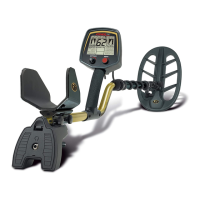LCD VISUAL DISPLAY
In normal operation, when the searchcoil passes over a metal object, the electrical signature
(2-digit I.D.) of the metal object is displayed on the numeric display for 4 seconds, unless
superceded by another detected object. On a given buried object, the number will bounce
around if the signal is weak or if the amount of ground mineralization is high.
At the top of the display, a block illuminates to indicate the classification of the object.
NUMERIC TARGET I.D. (2-digits)
The following table shows the numbers typically associated with certain commonly
encountered nonferrous metal objects. Older silver U.S. coins usually read about the same
as their modern clad equivalents. Modern quarter-sized dollar coins like the Susan B.
Anthony and the Sacagawea read about the same as a quarter. Many Canadian coins are
minted from a magnetic nickel alloy which gives very inconsistent readings and may
register as iron. Most one-ounce silver bullion coins will fall into the same range as the
modern U.S. $1 Eagle.
OBJECT TARGET I.D.
foil from gum wrapper 16-25
U.S. nickel (5¢ coin) typically 30
aluminum pull-tab 33-55
aluminum screwcap 60 - 70
zinc penny (dated after 1982) typically 60
aluminum soda pop can most often 63-69, but can vary widely
copper penny, clad dime typically 70
U.S. quarter (25¢ coin), clad typically 80
50¢ coin, modern clad typically 86
old silver dollar coin typically 90
US silver Eagle $1 coin typically 91
PROBABLE TARGET I.D.
The probable target ID zones at the top of the LCD display represent the signal ranges
produced by various coins and types of metal objects. When a metal target is detected, the
microcomputer analyzes the signal and categorizes it based on what kinds of metal objects
usually produce that kind of signal. The microprocessor then displays a block along the top
of the LCD screen above corresponding category.
For instance, if the detected signal fits within the parameters usually exhibited by zinc
pennies, the microcomputer will categorize the signal as "zinc penny". The LCD screen
will then illuminate the block above the “ZINC”
Copper pennies (pre-1982) will usually register in the DIME zone.
Most gold jewelry is small, and will tend to read in the 16-55 range. Silver jewelry usually
has more metal in it and therefore tends to produce higher readings.

